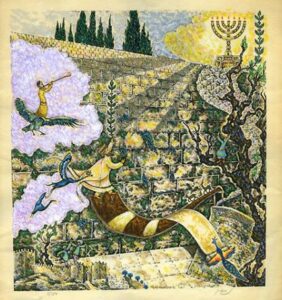בס”ד
By Rabbi Moshe Goodman, Kollel Ohr Shlomo, Hebron

These days before Tisha Bav and Shabbat Hazon carry a tightened awareness towards the rebuilding of Temple. This painting, set at the Western Wall, remnant of the Temple, with the Menora at its top, radiating below on the entire scene, expresses this yearning for the rebuilding of the Temple. Of course, the rebuilding of Hebron, identified by the Arizal as “Zion”, is instrumental in the rebuilding of Jerusalem and the Temple, which the Arizal associates with the term “Jerusalem.”
In this painting we see a man “riding” upon a shofar carrying a myrtle/olive branch . We see a Torah scroll surrounding the shofar. Altogether we see five hasidim, apparently corresponding to the five sefirot from hesed to hod. The man “riding” upon a shofar carrying a myrtle/olive branch may signify a Kohen, associated with hesed/Hochma, since he carries an olive branch which has its parallel next to the Menora, evoking Zecharia’s vision (4, 3) in which a Menora was seen with two olive branches to its right and left. The Menora is known to be a symbol of the Temple/kohanim who lit the Menora, and therefore it seems that the man carrying the olive branch is/represents a kohen. In addition, the Torah scroll surrounding the shofar may hint to the verse said about the priests “your [the kohen’s] Torah to Israel. The shofar itself, a symbol of repentance and return to God, may hint to the return to the Temple as hinted by the Menora and olive branch at the top of the painting. The gazelle pair seen on the shofar may hint to the love between Hashem and Israel, as the verse says “Ayelet – a deer/gazelle – Ahavim [of love] and Yelet Chen” (Proverbs 5:19 ). This may signify the return of Israel by Hashem to the Temple service with Divine love. The man riding an eagle playing a trumpet may hint to a Levite who played instruments in the Temple, and a Levite is associated to the attribute of gevura/Bina [also sometimes an eagle refers to Bina according to various Kabbalistic sources]. The man on the tree may refer to the Israelite associated with tiferet, since trees are considered also a symbol of tiferet. The two dancing hasidim at the bottom of the painting may hint to netzach and hod which are paired sefirot according to the Kabbalah and they are also associated to the legs by which one dances.
If we consider the two branches seen here as myrtle branches they may be corresponding to Zachor and Shamor, as related in the story of Rashbi’s return from the cave in Talmud (Tractate Shabbat). Therefore these are symbols of the Shabbat when the Holy Presence rests among us in the medium of time. Also there is the Menora seen here which our Sages also consider a symbol of the Holy Presence resting in the Temple, I.e the medium of space.



